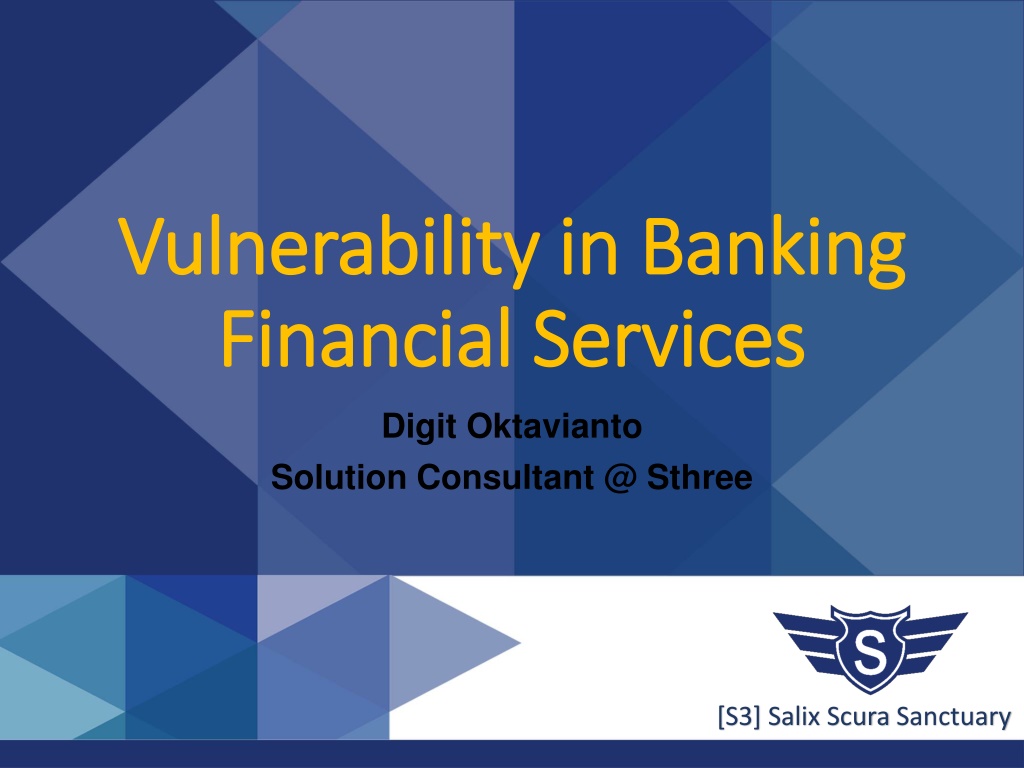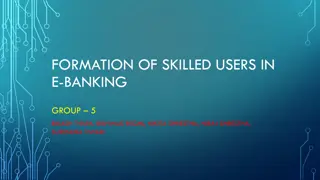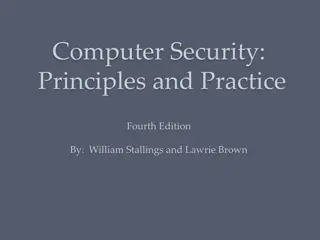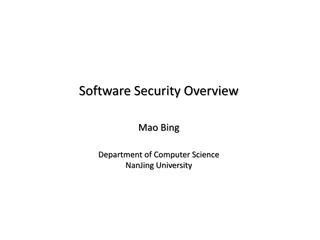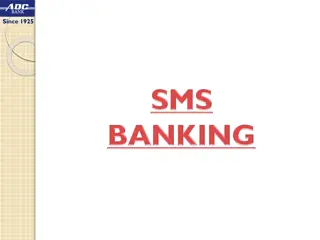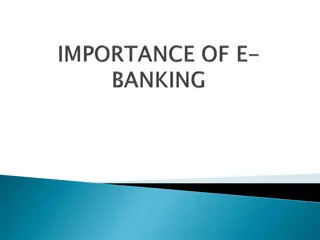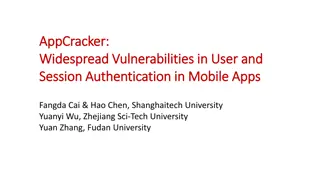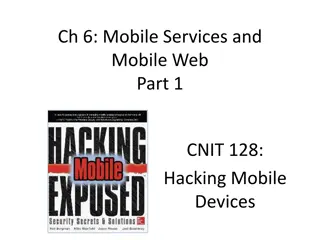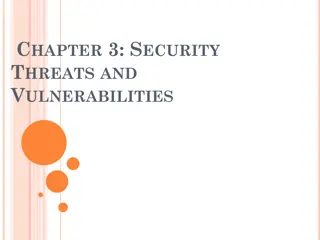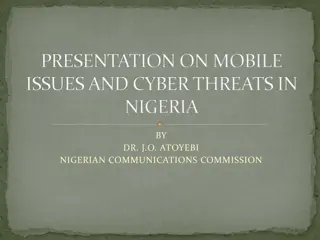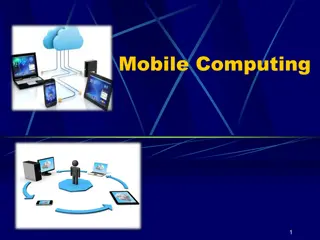Emerging Threats in Banking: Mobile Banking Vulnerabilities
Mobile banking apps face emerging threats such as mobile malware, third-party apps with poor security practices, unsecured Wi-Fi networks, and risky user behaviors. Security experts have uncovered vulnerabilities like lack of Certificate Pinning, enabling man-in-the-middle attacks. These issues pose significant challenges to the security of mobile banking systems.
Download Presentation

Please find below an Image/Link to download the presentation.
The content on the website is provided AS IS for your information and personal use only. It may not be sold, licensed, or shared on other websites without obtaining consent from the author. Download presentation by click this link. If you encounter any issues during the download, it is possible that the publisher has removed the file from their server.
E N D
Presentation Transcript
Vulnerability in Banking Vulnerability in Banking Financial Services Financial Services Digit Oktavianto Solution Consultant @ Sthree [S3] Salix Scura Sanctuary [S3] Salix Scura Sanctuary
Vulnerability in Banking Vulnerability in Banking Financial Service Financial Service KOMINFO Bandung - 6 September 2016 [S3] Salix Scura Sanctuary
About Me About Me Solution Consultant @Sthree Almost 2 Years in Banking (Compliance and Security) 5+ Years in IT Security Consultant Member Indonesian Honeynet Chapter Member OWASP Indonesian Chapter Linux Activist (KPLI Jakarta) [S3] Salix Scura Sanctuary
Banks Vulnerability in Application, Bank s Vulnerability in Application, Network, ATM, and POS System Network, ATM, and POS System Mobile Banking Apps: Emerging Threats, Vulnerabilities and Counter-Measures Device tapping (MITM) behind the ATM Network ATM Malware on The Rise Attacking POS System via Skimming and Malware SWIFT Attack [S3] Salix Scura Sanctuary
Mobile Banking: Emerging Threats, Mobile Banking: Emerging Threats, Vulnerabilities and Counter Vulnerabilities and Counter- -Measures Measures Mobile Malware - Trojans, viruses and rootkits migrating from traditional online banking and designed specifically for the mobile marketplace. Researchers see an increase in mobile malware development - in pace with market growth. Third-Party Apps - Consumers love their smart phone and tablet applications, but often these apps come from third parties with questionable security practices. Or worse, the apps are created by fraudsters and loaded with malware. Unsecured Wi-Fi - The unsecured wireless network is a toll-free highway for fraudsters to gain access to mobile devices, either to seize control of or gain access to account information. User Behavior - Consumers are prone to download third-party apps, use unsecured wireless networks, open and click links in SMS text messages and e-mails, and lose their mobile devices. Mobile-use behavior is creating a suite of vulnerabilities, and fraudsters are eager to take advantage. [S3] Salix Scura Sanctuary 5
Mobile Banking: Emerging Threats, Mobile Banking: Emerging Threats, Vulnerabilities and Counter Vulnerabilities and Counter- -Measures Measures Case Study : https://boris.in/blog/2016/the-bank-job/ Security Expert discovered that the mobile app lacks Certificate Pinning, allowing any man-in-the-middle attacker to downgrade SSL connection and capture requests in plain text using fraudulently issued certificates. He also found that the mobile banking app had insecure login session architecture, allowing an attacker to perform critical actions on the behalf of targeted account holder without knowing the login password, like seeing victim's current account balance and deposits, as well as to add a new beneficiary and making illegal transfers. [S3] Salix Scura Sanctuary
Device tapping (MITM) behind the Device tapping (MITM) behind the ATM Network ATM Network [S3] Salix Scura Sanctuary
Device tapping (MITM) behind the Device tapping (MITM) behind the ATM Network ATM Network There s a new kind of crime doing the rounds, which involves hijacking the ethernet cable of an ATM to gather card information. It uses a device that s plugged into the machine s network cable to harvest your card details, while a PIN can be captured using a separate camera or keypad overlay. Such hardware has already been used to successfully attack NCR and Diebold ATMs These attacks represent a continuation of the trend where criminals are finding alternative methods to skim magnetic strip cards. Such alternative methods avoid placing the skimmer on the ATM card entry bezel, which is where most anti-skimming technology is located. [S3] Salix Scura Sanctuary
ATM Malware on The Rise ATM Malware on The Rise [S3] Salix Scura Sanctuary
ATM Malware on The Rise ATM Malware on The Rise The main issue leading to the spread of malware is poor physical ATM security. Once attackers are able to open the enclosure, they install malware, usually by inserting a USB or CD that has the malicious code Many ATMs operate on Windows XP, which is now obsolete, and rely on outdated security software, they are extremely vulnerable and attractive targets for attack ATMs operating on outdated software across the globe creates a huge attack surface. It is clear that temporary fixes like new control locks and alarm systems will not stop the bleeding. Anti-Virus software used by ATMs is unable to protect against this type of attack for several reasons. [S3] Salix Scura Sanctuary
Attacking POS System via Attacking POS System via Skimming and Malware Skimming and Malware When an individual pays by swiping a credit card at a POS system, data contained in the card s magnetic stripe is read and then passed through a variety of systems and networks before reaching the retailer s payment processor Many POS systems are running older operating systems, such as Windows XP or Windows XP Embedded. These versions are more susceptible to vulnerabilities and are therefore more open to attack. Slow adoption of EMV standard for payments. [S3] Salix Scura Sanctuary
Attacking POS System via Attacking POS System via Skimming and Malware Skimming and Malware Typical anatomy attack on POS Systems : Attacks against POS systems in mature environments are typically multi-staged. First, the attacker must gain access to the victim s network. Usually, they gain access to an associated network and not directly to the CDE. They must then traverse the network, ultimately gaining access to the POS systems. Next, they will install malware in order to steal data from the compromised systems. As the POS system is unlikely to have external network access, the stolen data is then typically sent to an internal staging server and ultimately exfiltrated from the retailer s network to the attacker. [S3] Salix Scura Sanctuary
Attacking POS System via Attacking POS System via Skimming and Malware Skimming and Malware PoS malware is described in four categories: Network Sniffer File Scraper Keylogger Memory Scraper [S3] Salix Scura Sanctuary
Attacking POS System via Attacking POS System via Skimming and Malware Skimming and Malware [S3] Salix Scura Sanctuary
Vulnerability in SWIFT Due to Vulnerability in SWIFT Due to Recent Hacking Activities Recent Hacking Activities Uses malware to circumvent local security systems of a target bank. Gains access to the SWIFT international messaging network. Sends fraudulent messages via SWIFT to initiate money transfers from accounts at larger banks. [S3] Salix Scura Sanctuary
Vulnerability in SWIFT Due to Vulnerability in SWIFT Due to Recent Hacking Activities Recent Hacking Activities How Bangladesh Bank's SWIFT software was hacked with malware. (Source: BAE Systems Applied Intelligence.) [S3] Salix Scura Sanctuary
Vulnerability in SWIFT Due to Vulnerability in SWIFT Due to Recent Hacking Activities Recent Hacking Activities The malware registers itself as a service and operates within an environment running SWIFT s Alliance software suite, powered by an Oracle Database. By modifying the local instance of SWIFT Alliance Access software, the malware grants itself the ability to execute database transactions within the victim network This malware appears to be just part of a wider attack toolkit and would have been used to cover the attackers' tracks as they sent forged payment instructions to make the transfers [S3] Salix Scura Sanctuary
How Can Digital Signature & Digital How Can Digital Signature & Digital Certificate Protect Banking Institution Certificate Protect Banking Institution Apply SSL/TLS to transport channels that the mobile app will use to transmit sensitive information, session tokens, or other sensitive data to a backend API or web service. Securing mobile banking with SSL certificate pinning SSL should be enabled on both the server and the client for ATM Machine. It allows the ATM client to authenticate the host server, and ensures the integrity of the messages. [S3] Salix Scura Sanctuary
How Can Digital Signature & Digital How Can Digital Signature & Digital Certificate Protect Banking Institution Certificate Protect Banking Institution Point of Sales System can implement internal Certificate Authority (CA) to protect and secure multi-location communications across thousands of POS and company-owned computers. [S3] Salix Scura Sanctuary
FINISH FINISH THANK YOU! Q & A [S3] Salix Scura Sanctuary
